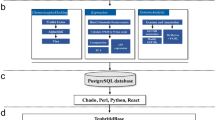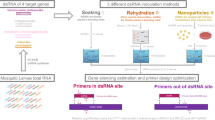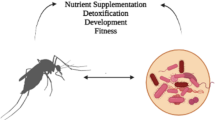Abstract
Culex pipiens mosquitoes are important disease vectors inhabiting temperate zones, worldwide. The seasonal reduction in temperature and photoperiod accompanying late summer and early fall prompts female mosquitoes to enter diapause, a stage of developmental arrest and physiological conditioning that enhances survival during the winter months. To investigate the molecular mechanisms underlying diapause induction, we used custom whole transcriptome microarrays to identify differences in gene expression following exposure to nondiapause (long days, 25 °C) and diapause-inducing (short days, 18 °C) environmental conditions. Using a two-way ANOVA, we identified 1130 genes that were differentially expressed. We used the expression of these genes across three time points to construct a gene co-expression network comprising five modules. Genes in modules 1, 2, and 3 were largely up-regulated, while genes in modules 4 and 5 were down-regulated when compared to nondiapause conditions. Pathway enrichment analysis of the network modules revealed some potential regulatory mechanisms driving diapause induction. Module 1 was enriched for genes in the TGF-ß and Wnt signaling pathways; module 2 was enriched for genes involved in insect hormone biosynthesis, specifically, ecdysone synthesis; module 3 was enriched for genes involved in chromatin modification; and module 5 was enriched for genes in the circadian rhythm pathway. Our results suggest that TGF-β signaling and chromatin modification are key drivers for the integration of environmental signals into the diapause induction phase in C. pipiens mosquitoes.




Similar content being viewed by others
References
Ahringer J (2000) NuRD and SIN3 histone deacetylase complexes in development. Trends Genet 16:351–356
Arensburger P, Megy K, Waterhouse RM et al (2010) Sequencing of Culex quinquefasciatus establishes a platform for mosquito comparative genomics. Science 330:86–88
Benjamini Y, Hochberg Y (1995) Controlling the false discovery rate: a practical and powerful approach to multiple testing. J Royal Stat Soc Ser B 57:289–300
Benoit JB, Denlinger DL (2007) Suppression of water loss during adult diapause in the northern house mosquito, Culex pipiens. J Exp Biol 210:217–226
Bolstad BM, Irizarry RA, Astrand M, Speed TP (2003) A comparison of normalization methods for high density oligonucleotide array data based on variance and bias. Bioinformatics 19:185–193
Bünning E (1936) Die endogene tagesrhythmik als grundlage der photoperiodischen reaktion. Ber Dtsch Bot Ges 54:590–607
Denlinger DL (2002) Regulation of diapause. Annu Rev Entomol 47:93–122
Eldridge BF (1968) The effect of temperature and photoperiod on blood-feeding and ovarian development in mosquitoes of the Culex pipiens complex. Am J Trop Med Hyg 17:133–140
Fonseca DM, Keyghobadi N, Malcolm CA, Mehmet C, Schaffner F, Mogi M, Fleischer RC, Wilkerson RC (2004) Emerging vectors in the Culex pipiens complex. Science 303:1535–1538
Harb M, Faris R, Gad AM, Hafez ON, Ramzy R, Buck AA (1993) The resurgence of lymphatic filariasis in the Nile delta. B World Health Organ 71:49–54
Inoue T, Thomas JH (2000) Targets of TGF-b signaling in Caenorhabditis elegans dauer formation. Dev Biol 217:192–204
Kanehisa M, Goto S (2000) KEGG: Kyoto encyclopedia of genes and genomes. Nucleic Acids Res 28:27–30
Kanehisa M, Goto S, Sato Y, Kawashima M, Furumichi M, Tanabe M (2014) Data, information, knowledge and principle: back to metabolism in KEGG. Nucleic Acids Res 42:D199–D205
Kang DS, Denlinger DL, Sim C (2014) Suppression of allatotropin simulates reproductive diapause in the mosquito Culex pipiens 64: 48–53
Langfelder P, Horvath S (2008) WGCNA: an R package for weighted correlation network analysis. BMC Bioinform 9:559
Lawson D, Arensburger P, Atkinson P, Besansky NJ, Bruggner RV, Butler R, Campbell KS, Christophides GK, Christley S, Dialanas E et al (2009) VectorBase: a data resource for invertebrate vector genomics. Nucleic Acids Res 37:583–587
Mattingly PF, Rozeboom LE, Knight KL, Laven H, Drummond FH, Christophers SR, Shute PG (1951) The Culex pipiens complex. Trans R Ent Soc Lond 102:331–382
Mitchell CJ (1983) Differentiation of host-seeking behavior from blood-feeding behavior in overwintering Culex pipiens (Diptera: Culicidae) and observations on gonotrophic dissociation. J Med Entomol 20:157–163
Ng H-H, Bird A (2000) Histone deacetylases: silencers for hire. Trends Biochem Sci 25:121–126
Nguyen M, Parker L, Arora K (2000) Identification of maverick, a novel member of the TGF-β superfamily in Drosophila. Mech Develop 95:201–206
Ravasz E, Somera AL, Mongru DA, Oltvai ZN, Barabási AL (2002) Hierarchical organization of modularity in metabolic networks. Science 297:1551–1555
Rhinehart JP, Robich RM, Denlinger DL (2006) Enhanced cold and desiccation tolerance in diapausing adults of Culex pipiens, and a role for Hsp70 in response to cold shock but not as a component of the diapause program. J Med Entomol 43:713–722
Robich RM, Denlinger DL (2005) Diapause in the mosquito Culex pipiens evokes a metabolic switch from blood feeding to sugar gluttony. PNAS 102:15912–15917
Robich RM, Rinehart JP, Kitchen LJ, Denlinger DL (2007) Diapause-specific gene expression in the northern house mosquito, Culex pipiens L., identified by suppressive subtractive hybridization. J Insect Physiol 53:235–245
Schuettengruber B, Martinez A-M, Iovino N, Cavalli G (2011) Trithorax group proteins: switching genes on and keeping them active. Nat Rev Mol Cell Bio 12:799–814
Shannon P, Markiel A, Ozier O, Baliga NS, Wang JT, Ramage D, Amin N, Schwikowski B, Ideker T (2003) Cytoscape: a software environment for integrated models of biomolecular interaction networks. Genome Res 13:2498–2504
Siebold AP, Banerjee R, Tie F, Kiss DL, Moskowitz J, Harte PJ (2009) Polycomb repressive complex 2 and trithorax modulate Drosophila longevity and stress resistance. Proc Natl Acad Sci U S A 107:169–174
Sim C, Denlinger DL (2008) Insulin signaling and FOXO regulate the overwintering diapause of the mosquito Culex pipiens. PNAS 105:6777–6781
Sim C, Denlinger DL (2009) A shut-down in expression of an insulin-like peptide, ILP-1, halts ovarian maturation during the overwintering diapause of the mosquito Culex pipiens. Insect Mol Bio 18:325–332
Sim C, Denlinger DL (2013) Insulin signaling and the regulation of insect diapause. Front Physiol 4:189
Smoot M, Ono K, Johannes Ruscheinski J, Wang P-L, Ideker T (2011) Cytoscape 2.8: new features for data integration and network visualization. Bioinformatics 27:431–432
Spielman A (1974) Effect of synthetic juvenile hormone on ovarian diapause of Culex pipiens mosquitoes. J Med Entomol 11:223–225
Spielman A, Wong J (1973) Environmental control of ovarian diapause in Culex pipiens. Ann Entomol Soc Am 66:905–907
Sturn A, Quackenbush J, Trajanoski Z (2002) Genesis: cluster analysis of microarray data. Bioinformatics 18:207–208
Untergasser A, Nijveen H, Rao X, Bisseling T, Geurts R, Leunissen JA (2007) Primer3Plus, an enhanced web interface to Primer3. Nucleic Acids Res 35:W71–W74
Vinogradova EB (2000) Culex pipiens pipiens mosquitoes: taxonomy, distribution, ecology, physiology, genetics, applied importance and control. Pensoft, Sofia
Wang J, Duncan D, Shi Z, Zhang B (2013) WEB-based GEne SeT AnaLysis Toolkit (WebGestalt): update 2013. Nucleic Acids Res 41:W77–W83
Waterhouse RM, Tegenfeldt F, Li J, Zdobnov EM, Kriventseva EV (2013) OrthoDB: a hierarchical catalog of animal, fungal and bacterial orthologs. Nucleic Acids Res 41:D358–D365
Zhang B, Kirov SA, Snoddy JR (2005) WebGestalt: an integrated system for exploring gene sets in various biological contexts. Nucleic Acids Res 33:W741–W748
Acknowledgments
We thank Ryan Hemme for collecting the larvae used in establishment of the C. pipiens South Bend strain. We also thank Melissa Stephens in the University of Notre Dame Genomics Core Facility for processing the microarrays. This work was supported by the National Institute of Allergy and Infectious Diseases, National Institutes of Health (RO1-AI079125-A1) to D.W.S.
Conflict of interest
The authors declare that they have no conflict of interest.
Author information
Authors and Affiliations
Corresponding author
Rights and permissions
About this article
Cite this article
Hickner, P.V., Mori, A., Zeng, E. et al. Whole transcriptome responses among females of the filariasis and arbovirus vector mosquito Culex pipiens implicate TGF-β signaling and chromatin modification as key drivers of diapause induction. Funct Integr Genomics 15, 439–447 (2015). https://doi.org/10.1007/s10142-015-0432-5
Received:
Revised:
Accepted:
Published:
Issue Date:
DOI: https://doi.org/10.1007/s10142-015-0432-5




